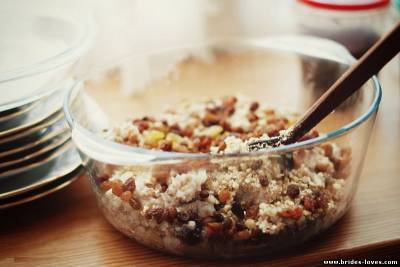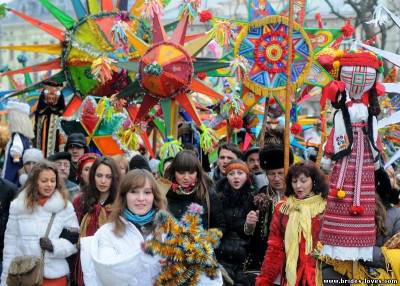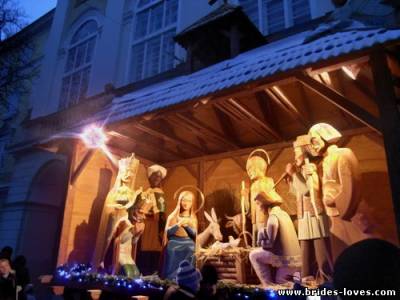02:45 Christmas | |
|
! Christmas Traditions in Ukraine. We start celebrate Christmas in Ukraine January 7, according to the Gregorian calendar as in most of other Orthodox Christian countries. The Christmas Eve is called in Ukraine ‘Sviaty Vechir’ (Holy Evening) sometimes also called‘Sviata Vecheria’ (Holy Supper). People usually cook some tasty foods for this evening. There should be at least 12 different foods on the table. A twelve-dish Christmas Eve supper is traditionally prepared in many Eastern European cultures, including Lithuanian , Polish , and Ukrainian (cultures of regions that were formerly part of the Polish-Lithuanian Commonwealth ). The meal ( Lithuanian : Kūčios , Polish : Wigilia or wieczerza wigilijna, Ukrainian : Свята вечеря , Sviata vecheria ) consists of twelve meatless dishes representing the twelve Apostles . The tradition of the supper can be traced back to pre-Christian times and connected with remembrance of the souls of deceased ancestors . In some parts of Poland a similar tradition of thirteen meatless dishes on Christmas Eve is practiced. The specific dishes may differ from country to country, but many of them are universal. Due to the Nativity Fast , no meat, eggs or milk (including cheese) are allowed during the supper. Thus fish, mushrooms and various types of grain are the main offerings. In Poland and Ukraine the supper begins with eating soup. Kutia , poppy milk (aguonų pienas) together with kūčiukai are served as a dessert and forms a significant part of the Lithuanian Christmas Eve menu. Poppy seeds are widely used for Christmas Eve dishes, because they symbolize abundance and prosperity. Regarding the fish dishes, usually herring , carp or pike are eaten. In Lithuania herring ( Lithuanian : silkė ) dishes are rich and variable. Usually silkė su morkomis(herring with carrots), or silkė su grybais (herring with mushrooms) are served on Christmas Eve. Mushrooms, especially dried or pickled, are also one of the main dishes eaten on Christmas Eve. Sauerkraut ( Polish :Kiszona kapusta, Russian : Ква ́ шеная капу ́ ста , Kváshyenaya kapústa) with wild mushrooms or peas , red borsch , mushroom or fish soups are eaten in Poland and Ukraine. Boiled or deep fried dumplings (Polish: pierogi , Ukrainian: вареники , varenyky , Lithuanian: auselės ) with a wide variety of fillings (including sweet cabbage, mushrooms and crushed poppy seeds), are among the most popular dishes. Doughnuts filled with jam (Polish:pączki, Ukrainian: пампушки , pampushky ) are served for a dessert in Ukraine, but in Lithuania sweet dishes are not common, as they are believed inappropriate for the atmosphere of the evening. As for beverages, traditionally dried fruit compote or cranberry kisiel ( Lithuanian : spanguolių kisielius ) are common[ citation needed ] . In earlier times oaten kisiel was more common. There is the whole ritual before the meal begins. Once the first star appears on the sky, each member of family washes his face, hands and legs in cold water saying: "Be as healthy as this water is." The most brave people go to local rivers or lakes and have a short swim there. After the water procedure is finished, the family goes on with a prayer, often the Our Father . [1] After the prayer the head of the household will anoint each person present with honey , making the sign of the Cross on their forehead, saying: "In the name of the Father and of the Son and of the Holy Spirit : may you have sweetness and many good things in life and in the new year." The Christmas Eve supper is usually held under candlelight and starts in the evening after the first star appears in the sky. The star symbolizes the birth of Jesus in Christian tradition and a soul of deceased ancestors in pre-Christian beliefs. Quiet, dim-lighting, and a somewhat mystical atmosphere is characteristic for Christmas Eve supper. In Poland, western Ukraine, and Bukovyna, an extra plate and seat are always left for anyone, such as a drifter, or for deceased loved one to be accepted as a guests. Those should mandatory include ‘Kutia’ -- the ritual food which is prepared from cooked wheat and special syrup containing diluted honey, grated poppy seeds, raisins and sometimes walnuts. Kutia is a sweet grain pudding, traditionally served in Ukraine , Belarus , Russia and some parts of Poland . Sochivo, a dish similar to kutia, is very popular in Russia . Kutia is often the first dish in the traditional twelve-dish Christmas Eve supper (also known as Svyatah Vecherya). It is rarely served at other times of the year. At the end of the Sviata Vechera the family often sings Ukrainian Christmas carols . In many communities the ancient Ukrainian tradition of caroling is carried on by groups of young people and members of organizations and churches calling at homes and collecting donations. The Ukrainian song " Shchedryk " became the basis for the world famous Christmas carol, " Carol of the Bells ". Another well-known carol is Boh predvičnyj narodilsja . When the children see the first star in the eastern evening sky, symbolizing the trek of the Three Wise Men , the Sviata Vecherya may begin. In farming communities the head of the household now brings in a sheaf of wheat called the didukh which represents the importance of the ancient and rich wheat crops of Ukraine, the staff of life through the centuries. Didukh means literally "grandfather spirit" so it symbolizes the family's ancestors. In city homes a few stalks of golden wheat in a vase are often used to decorate the table. Shopka is a traditional portable nativity scene used to represent nativity and other figures in a puppet form.
3 прикрепленных файла Предварительный просмотр файла Holy_Eve_cooking._Kutia.jpg
| |
|
| |
| Total comments: 0 | |


